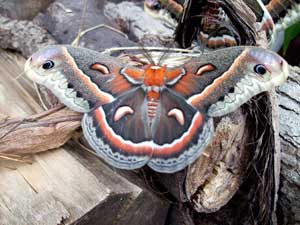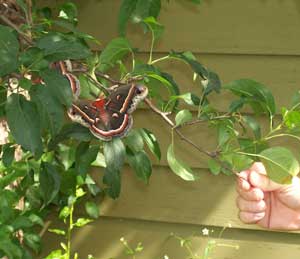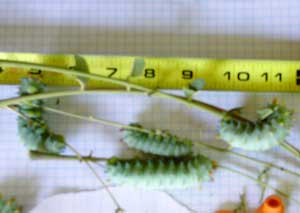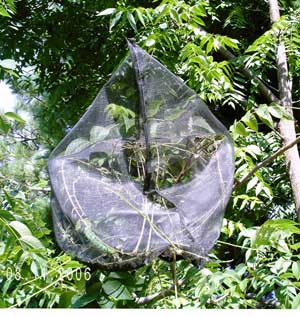Moth Man.
My story.
I don't consider myself a moth expert but I have had 10 years of success in raising a few species of 'giant silk worms' and in the process I have
learned a great deal about these particular moths. Cecropia (Hyalophora
cecropia) is my favorite. Followed closely by the Promethia (Callosamia promethea), the female of which looks very much like the cecropia except much smaller. The male is the same size as the female but much darker in color (looks nearly black when flying). I'm not a big fan of the Polyphemus (Antheraea polyphemus) mainly because it is too much in a hurry to do everything (it can actually emerge twice in one year) and the caterpillars give me the heebie jeebies.
Before raising these moths I had only seen one in my life (and now I
'see' them every year). They are amazing creatures and they do very
little damage. My segment on Wisconsin Public Television; "Wisconsin Gardner" is intended to
demonstrate this to people so that if they see these caterpillars on
their trees they will recognize what they are -- and what they will
become -- and therefore leave them alone.
It is a beautiful moth and the larvae
(caterpillar) is impressive (beautiful in it's own way.) Both little
kids and adults seem to get a kick our of raising these moths and I
furnish eggs each year to anyone who asks (while supplies last).
Another reason I raise them is because these moths are native to our
area and are they on the decline. The decline is partially due to biological control of the gypsy moth. Many of the techniques people use
to kill the gypsy moth (an imported pest) also kill the Cecropia and
it's relatives. The worst of these is a small fly which was imported
from Europe to kill the gypsy moth but is also killing huge numbers of
other moths - Cecropia included.
Raising these moths is easy. They emerge from their cocoons in June each
year. The moths don't have any mouths so they can't eat. Their only
purpose is to fly around - looking beautiful - to find a mate.
After mating, the female flies around and lays a total of about 100 eggs and
then she dies.
Within a week the eggs hatch and the caterpillars start
munching on tree leaves. They will grow through 4 stages to be as large
as your finger.
In early september they spin their cocoon where they
spend the winter.
The following June they emerge as moths and the cycle
repeats.
I started raising the larvae (caterpillars) in a small aquarium in our
living room. I'd put twigs in a bottle of water (to keep the leaves
fresh while the larvae ate). When they had all the leaves eaten I'd
bring in a new branch. The main reason for the aquarium was to catch the
'poop' since the larvae don't try to get away - until it's time to spin their cocoon.
When they are done eating they start
searching for a good place to spin. One day my wife was reading the
newspaper at the table when 'plop' a large larva landed on the paper and
that was the end of raising larvae in the house.
Now I just put them right on the tree branch. I enclose the branch with
a bag made of ordinary nylon window screen closed at the top with a
piece of string or wire. This protects the growing larvae from predators
and keeps them where I can keep an eye on them while they grow.
After
they spin up their cocoon I cut off the twig and put in in my un-heated
garage over winter. In the spring I move the cocoons to my deck so they
will synchronize with nature.
The females use pheromones to attract
mates and males will be drawn from miles around. There have been years
when I've seen to a dozen male cecropia fluttering around the deck
trying to get at one female.
I usually just keep one female and her eggs
and let the rest fly away when they're ready. I save a few eggs for
raising and give the rest away. These go mostly to friends and
associates at work who have kids who want to try raising moths. Some go
to teachers for use in their classrooms. And one year I gave over a
hundred eggs to a student at UW Entomology Department who was doing
research on survival on trees in northern Wisconsin.
One year I got a
request (from my web site) for the spent cocoons from a researcher in
textile industry who is looking at qualities of the silk produced by
native silk worms.



